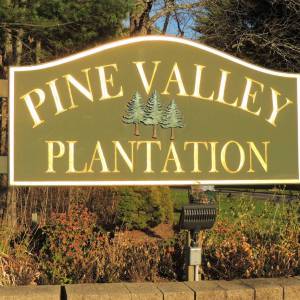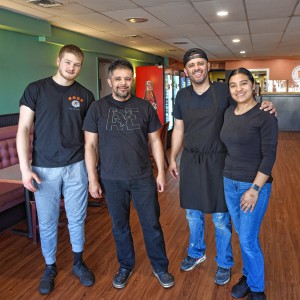Tradition of tobacco farming sees gradual resurgence in Hatfield
| Published: 09-15-2018 8:32 PM |
HATFIELD — Tobacco farming has been tied to this Valley town’s agricultural identity for at least 150 years. In fact, at the turn of the 20th century, Hatfield was the largest producer of tobacco in the commonwealth. Though its heyday has passed, the tradition remains strong in the town’s collective memory and some family farms are keeping it alive.
In 2016, there was only one family working tobacco in town, the Malinowskis. Kathie Gow, the curator at the Hatfield Historical Museum, had the foresight to document their work, thinking that it might be the end of an era. Then this year she got an email from a resident, relatively new to town, amazed by the “ancient tractors” pulling wagons of leaves through the streets and slowing traffic. Gow, already planning a tobacco exhibit for the town’s 350th anniversary in 2020, snapped new photos, this time of the Wendolowski family working, and posted these to the Hatfield Historical Society’s Facebook page, inspiring a cascade of stories and memories in the replies from many who had worked tobacco as kids.
This is the time of year, driving through a number of Connecticut River towns, when you might find yourself slowing down for one of these tractors. But those with a deeper personal connection to Hatfield have already noticed the slight return of activity in the fields.
“Oh my gosh. They’ve got more tobacco at Billy Boyle’s this year.” That’s what lifelong resident Patricia Douglas, 83, thought to herself one day this summer as she drove past fields of broadleaf tobacco at the Boyle Farm on Chestnut Street — the same farm she had worked on as an 11-year-old. During an interview at the Hatfield Historical Museum on Tuesday, Douglas noted that her family was also growing tobacco at the time, Havana leaf, so she was only allowed to work at the Boyle Farm on days when she was all caught up on her family’s farm. Back then, the Boyle Farm was one of many farms producing shade tobacco commercially for the Meyer & Mendelsohn Company. Shade was the dominant variety grown at that time and for years to come, distinguished to many by the familiar white netting under which it was grown.
Those varieties of leaf tobacco — the kinds used for wrapping, binding and filling cigars — have been a staple crop in Hatfield since the 1800s. And though there has been a steady decline in recent years, this year the leaf is being cultivated by three Hatfield families: the Malinowskis, Wendolowskis, and the Zgrodniks.
It’s an early afternoon in late August, and Jeff Zgrodnik of Honey Pot Farm is directing a crew of a dozen friends, relatives, neighbors and other hired help busy chopping tobacco on that same Boyle Farm of Pat Douglas’ youth. The putt-putt of several colorful “ancient tractors” can be heard as they hover around the perimeter of the field like so many small airplanes taxiing for take off. Zgrodnik, the would-be traffic controller, waves the next one into the field between rows of cut tobacco plants lying flat on the ground. After 20 inches of rain in three weeks, he is thankful for the sunshine and the chance to get going. “We were blessed today,” he says, noting the perfect weather for harvesting tobacco — a slight breeze and some cloud cover. Once the tobacco plants are chopped down, the leaves are allowed to wilt on the ground before being posted to lathes on the waiting tractors and driven to the drying barns. But if they lie in the direct sun too long they can actually get burned. And because they are a visual commodity — as cigar wrappers — the sensitive leaves are handled as gently as one would pick apples, being careful not to bruise. Zgrodnik adds, “It’s the one crop that can never be perfect enough.”
Donald Vollinger, 79, is one of Zgrodnik’s tractor drivers, idling in the shade of the treeline, waiting for his cue to enter the field. Relaxed in a T-shirt and shorts and sporting a Johnny Unitas flattop, he considers a question about when he first started working tobacco. “I was born on a farm and grew up on a farm, and my father was a tobacco farmer — so you figure it out.” He settles on “1946.” Like many in town, his father raised Havana leaf, a slightly smaller variety than today’s broadleaf, and grew it from seed. That meant two spring months of growing in a tobacco bed “under sash,” or under a short greenhouse, and transferring these plants into the fields. He nods in the direction of a large building bordering Chestnut Street and recalls sorting leaves there in high school. But this tobacco shop also had a special room to generate high heat and humidity. That’s where the commercially grown Candella variety of tobacco would be cured quickly to retain its green color. Vollinger also remembers the back-to-back hurricanes of 1954 that flooded this field and yielded a crop that salvaged only 13 cents per pound when the going rate was a dollar.
Up on Prospect Street, the tobacco in Mark Wendolowski’s barn has been curing for a good month. He grew up working in the tobacco fields of his father, Tony Wendolowski. But this year, after several years of not growing tobacco, Mark, now 45, planted his own 2½-acre crop which, with help from his college-age sons and friends, he harvested in July and hung in the barn across the street from his home. The leaves are browning nicely and may be ready as soon as next month to be cut and bundled and driven to a buyer in Connecticut.
Article continues after...
Yesterday's Most Read Articles
 South Hadley’s Lauren Marjanski signs National Letter of Intent to play soccer at Siena College
South Hadley’s Lauren Marjanski signs National Letter of Intent to play soccer at Siena College
 LightHouse Holyoke to buy Gateway City Arts, expand offerings and enrollment at alternative school
LightHouse Holyoke to buy Gateway City Arts, expand offerings and enrollment at alternative school
 Treehouse, Big Brothers Big Sisters turn race schedule snafu into positive
Treehouse, Big Brothers Big Sisters turn race schedule snafu into positive
 South Hadley man fatally shot in attempted robbery
South Hadley man fatally shot in attempted robbery
 Granby man admits guilt, gets 2½ years in vehicular homicide
Granby man admits guilt, gets 2½ years in vehicular homicide
 Area briefs: Transhealth to celebrate 3 year; Holyoke to plant tree at museum; Documentary film about reparations focus of Unitarian talk
Area briefs: Transhealth to celebrate 3 year; Holyoke to plant tree at museum; Documentary film about reparations focus of Unitarian talk
Last week, Hatfield natives Richie and Riley Malinowski — themselves children of farmers — and their sons, Alex, 19, and Tucker, 16, spent the day together chopping and hanging the last of this year’s broadleaf tobacco crop in their barn on Plain Road. Both Richie and Riley have worked tobacco since they were kids and their sons also started at an early age, stripping the dried leaves from the stalks, or riding on the setter, a device for transplanting the seedlings, with their father, or Richie’s father. Now they’re versed in everything from transplanting and harvesting to monitoring moisture content and “firing,” or using burners in the barn to accelerate the drying process. They are getting ready to take over the family business.
Pat Douglas, the daughter and granddaughter of tobacco farmers, says she was “born into working tobacco.” As soon as she could walk, she was helping out by collecting the errant Havana leaves that had fallen to the ground in her family’s drying barns and giving them to her mother to sew and hang again. Later, she toddled behind the mechanical planter in the field with a bucket of seedlings, ready to fill in any spaces that the machine had missed. In those years, Hatfield farmers concentrated on this cash crop. “Back then, it was just tobacco. There was a limited amount of potatoes and onions, but most everybody — and all the kids around here whose parents were farmers — worked on tobacco.”
And tobacco took a lot of attention. Once the leaves were hung and dried completely they were too brittle to be taken down from the barn without breaking. So the growers would wait for what they called a “damp,” a rainy or muggy day, to soften up the leaves — no matter the time of day. Douglas says that if her father deemed the best “damp” was at one o’clock in the morning, they’d still have to get up and do it, then come home, shower and get ready for school.
Douglas recalls her first day working away from the family farm. “When I was 11, I was outside playing and Joe Smith, who lived across the street — he was the owner of many fields and had a tobacco shop — he said, ‘Pat, you look old enough. Get on the wagon. I’m taking you to work.’ I said, ‘Let me tell my mother first where I’m going.’ She said fine. So, that’s how I started working on the shade tobacco. And from 11 till the time I went into nurse’s training (at Cooley Dickinson Hospital), I worked on Billy Boyle’s farm in the summer. Made money — enough to pay for my nursing education — which wasn’t very much back then.”
For her last seven or eight years working tobacco, Douglas sewed the freshly cut leaves by hand, with needle and thread, onto lathes that were hung in the barn to dry, making as much as $11 a day in piecework when the less-experienced kids were making five or six dollars. After paying for her nurses training, Douglas entered the Air Force Nurse Corps for five years — she motions to her starched white uniform displayed in a glass case nearby — but never went back to tobacco. She has many fond memories of working in the fields and barns but has opted to donate several personal photos of those years to the Hatfield Historical Museum archives. “Because what are my kids going to do with them?” she says, laughing. “They don’t know what tobacco is.”
Kevin Gutting can be reached at kgutting@gazettenet.com
 Area property deed transfers, April 25
Area property deed transfers, April 25 Belchertown mobile home village getting new water system
Belchertown mobile home village getting new water system Primo Restaurant & Pizzeria in South Deerfield under new ownership
Primo Restaurant & Pizzeria in South Deerfield under new ownership Amherst regional district towns seek middle ground on school increase
Amherst regional district towns seek middle ground on school increase
